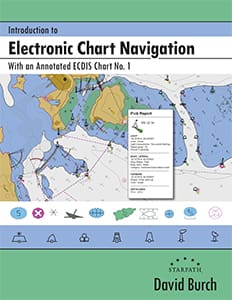Introduction to Electronic Chart Navigation
by David Burch
Starpath Navigation (www.starpath.com)
138 pages
David Burch’s book is a comprehensive look at what electronic charts are, how they work, and how to use them.
He breaks the guide into four chapters, including an extensive and valuable compendium on chart symbols. Probably the most important section, though, is the introduction, where he spells out the definition of an electronic chart and the types that exist — basically varieties of either raster charts (RNC) or vector (ENC) charts.
I remember when I was first exposed to celestial navigation and the instructor began with an in-depth look at the spherical trigonometry that made sights and reductions work … it was almost overwhelming, and something I have never again needed when navigating. However, this is not the case with Mr. Burch’s introductory approach. Knowing the difference between the types of charts you might be viewing — and why they are different — is critical to navigating safely with them; they do not behave the same way on a chartplotter.
The major difference is that the RNC is essentially a visual reproduction of a paper chart, while the ENC is an image created by software using the actual data (i.e. from a database) that is contained on a chart. While both show your place on the chart, only the ENC allows you to access the data that makes it work. For instance, if you put your cursor on a buoy on an ENC, your screen will display a pop-up of information relating to it. Not so on a RNC chart, which has no data attached to that buoy.
The clear preference in Mr. Burch’s book is the ENC, and rightly so. In subsequent chapters, he discusses the distinctions between the charts and then the value the ENC offers in terms of using them while underway. Having “data talk to data” is a powerful tool when it comes to having your charts open to integrated communications with your GPS, AIS, radar, etc. Otherwise, you are simply a dot on an electronic piece of paper.
There is no doubt that many of us may be unaware of what type of electronic chart we are looking at. Indeed, a good portion of sailors probably just want to turn on the chartplotter and see where they are. A responsible skipper, however, will learn from this book, and understand why it is important to know the differences between the chart types and their functionality — in much the same way it is important to understand the characteristics of the various anchors you might use to hold your boat safe.

